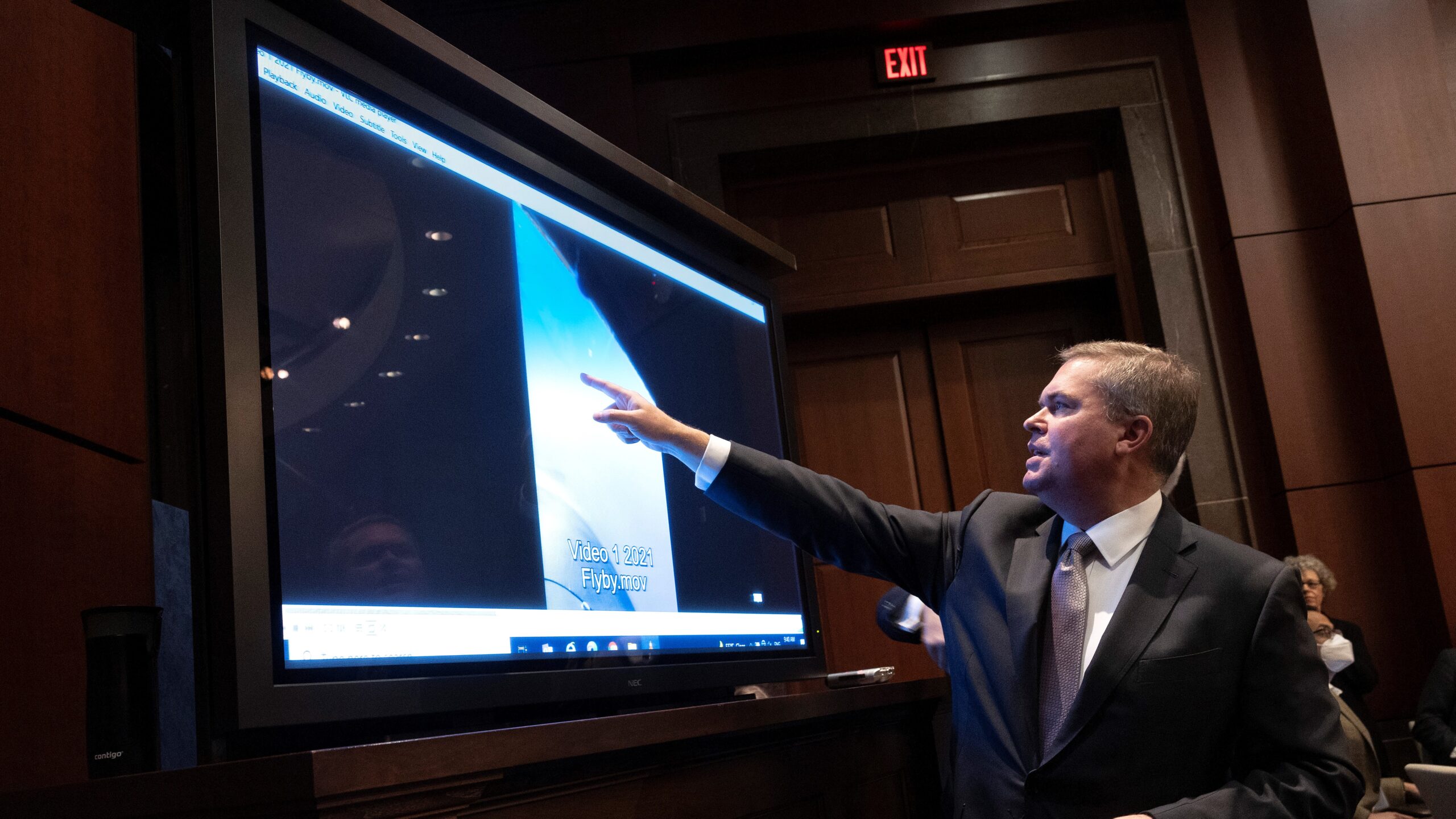
Deputy Director of Naval Intelligence Scott Bray explains a video of an unidentified aerial phenomena, as he testifies before a House Intelligence Committee subcommittee hearing at the U.S. Capitol on May 17, 2022. (Kevin Dietsch/Getty Images)
WASHINGTON: Military pilots have reported almost a dozen dangerous close approaches with what the Defense Department now calls “unidentified aerial phenomena” — and the general public calls UFOs — a senior Navy official told lawmakers today during the first open hearing on the issue in some 50 years.
“We’ve had at least 11 near misses,” over a 20 year period studied by the Pentagon, Scott Bray, the deputy director of naval intelligence, told a House Permanent Select Intelligence subcommittee. He added that military pilots have neither tried to communicate with a UAP, or fired upon one, during that time period.
Last November, DoD created the Airborne Object Identification and Management Synchronization Group (AOIMSG) under the Office of the Undersecretary of Defense for Intelligence and Security (OUSD(I&S) to take over from the Navy’s UAP Task Force.
That group was established in the wake of the Office of the Director of National Intelligence’s June 2021 “preliminary assessment” of reported UAP incidents [PDF]. That study examined 144 incidents dating back two decades — and could only explain a single one of them away.
Further, the report found: “In 18 incidents, described in 21 reports, observers reported unusual UAP movement patterns or flight characteristics. Some UAP appeared to remain stationary in winds aloft, move against the wind, maneuver abruptly, or move at considerable speed, without discernable means of propulsion.”
The Pentagon, however, is keen to make clear that it is serious about UAPs, which lawmakers have fretted could be counterintelligence operations by adversaries using advanced technologies. And thus DoD officials are urging operators to come forward with reports.
Ronald Moultrie, DoD I&S undersecretary, said in his opening remarks that the Pentagon is aware “there has been a ‘cultural stigma’ surrounding UAP reporting. Our goal is to eliminate this stigma by fully incorporating our operators and mission personnel into a standardized data gathering process.”
It seems to be working. Since the release of the preliminary report, a database developed by the Navy’s UAP Task Force has grown to 400 reported incidents, Bray said. “The stigma has been reduced,” he added.
Rep. André Carson, D-Ind., who chairs the counterterrorism, counterintelligence and counterproliferation subcommittee holding the hearings, pushed Moultrie for reassurances that DoD is looking at each incident with an open mind about its possible cause.
“You know, we fear sometimes that the DoD is focused more on emphasizing what it can explain, not investigating what it can’t. Looking for you to assure us today that all conclusions are on the table,” he said in his opening statement.
Moultrie responded that DoD is “open to all hypotheses, we’re open to any conclusions that we may encounter.” However, he added, “it is the department’s contention that, by combining appropriately structured collected data with rigorous scientific analysis, any object that we encounter can likely be isolated, characterized, identified, and, if necessary, mitigated.”
Moultrie explained that his office is in the throes of establishing the AOIMSG — although he noted that the name of the group is likely to change. And, he said, the Pentagon “just this week” has chosen a director, although he did not name that individual.
“That office’s function is clear: to facilitate the identification of previously unknown or unidentified airborne objects in a methodical, logical and standardized manner. These goals will ensure that we are working closely with operational personnel on training and reporting requirements; developing data and intelligence requirements; standardizing and integrating processes and procedures for collection, operational surveillance, analysis and reporting; leveraging our research and development capabilities to improve detection, characterization and identification of UAPs; developing mitigating solutions and procedures and identifying strategy and policy solutions,” he said.
“This effort will maximize collaboration and build upon already existing relationships with the Office of the Director of National Intelligence, the FAA, DHS and the FBI. We are also committed to strong partnerships with the Department of Energy, NOAA, the DEA, NASA, and the National Labs, and just as importantly, our national partners and allies,” he added.
Moultrie said that his office has worked with all the services to develop standardized reporting practices — including the Space Force, even though up to now the public focus largely has been on airborne UAPS. Further, the Intelligence Community is “on board and helping us work through this standardized methodology,” he said, noting that this is the first time the Pentagon has has such a process.
“We’re now bringing in data, analyzing that data, and reporting that data in the appropriate means, either get it to our service personnel to ensure their safety, or get it to you and the Congress and to the public,” he added.
Moultrie and Bray provided little specific information on questions such as the potential threat from advanced adversaries that some of the UAP reports might indicate, demurring answers to the closed classified portion of the hearing to follow the public one. Moultrie also refused to discuss whether any underwater UAPs have been detected.
“With regard to the importance of transparency, the department is fully committed to the principle of openness and accountability to the American people. However, we are also mindful of our obligation to protect sensitive sources and methods,” he said.
Australia tops up Ukraine military aid with $100M
Australia has already supplied Ukraine with 120 Bushmaster vehicles, six 155mm howitzers, 56 M113 armored vehicles, 14 special operations vehicles and its signature cardboard drones.


























